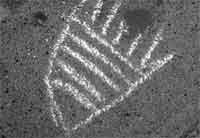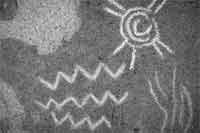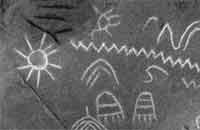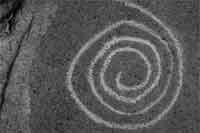




California must have been an interesting place in pre-Columbian times. It was the most populated area on the continent and the most diverse ethnically and linguistically. There were nine language families in the Sierra alone.
Native Americans left us a record of their presence in the Donner Summit area: petroglyphs. The pictures to the right are Donner Summit area petroglyphs enhanced in black and white. Similar symbols are found in many places in the northern Sierra Nevada, usually on gently sloping granite slabs.
The most accessible prehistoric rock art site is below Donner Pass on Old Hwy 40 between Rainbow Bridge and the Chinese Wall. Look on the flat granite bench just west of the road near the historical marker. This is an extensive petroglyph site that contains over 200 rock art elements, including a bear track (see top photo). The petroglyphs here are hard to see but fascinating.
Archeologists estimate that the petroglyphs in this area were made 1500 to 4000 years ago. They were created by pecking through the surface of the glaciated bedrock using a tool called a hammerstone. Most are geometric shapes – wavy lines, circles, and zigzags. Human and animal forms, such as stick figures and deer or bear tracks, are less common. Although no one knows what the petroglyphs mean, many people believe they have a spiritual or ceremonial significance.
Ancestors of the Washo People created these petroglyphs. Like all Great Basin Indians, they were nomadic. The Washo traveled all over the Sierra, and used Donner Pass as a corridor for travel to and from Lake Tahoe. Adapted to life in the Great Basin and the Sierra, they made annual rounds hunting game, gathering and trading food, clothing materials, salt and obsidian. They probably carried dried trout and pine nuts to eat and they would have hunted.
The rock art sites are exposed to the harsh environment of the high Sierra. The natural process of exfoliation (peeling away of layers of rock due to the freezing and expansion of water) is at work on Sierra granite. This leaves the petroglyphs fragile and vulnerable to destruction. To preserve these sacred symbols:
Walk around, not on, the petroglyphs.
Don’t make rubbings or tracings–this wears away the rock surface.
Leave rocks, plants and artifacts where they are.
And of course remove your trash.
Someday the petroglyphs will be gone and along with them will go the tangible record of the first visitors to Donner Summit.
There are many good sources for information about the earliest visitors to Donner Summit as well as the rock carvings. A particularly good source is Ancient Rock Carvings of the Central Sierra by Willis Gortner. You have to be really lucky to see a copy since it's out of print - but you may run into someone with a copy.
Anne Reisenauer